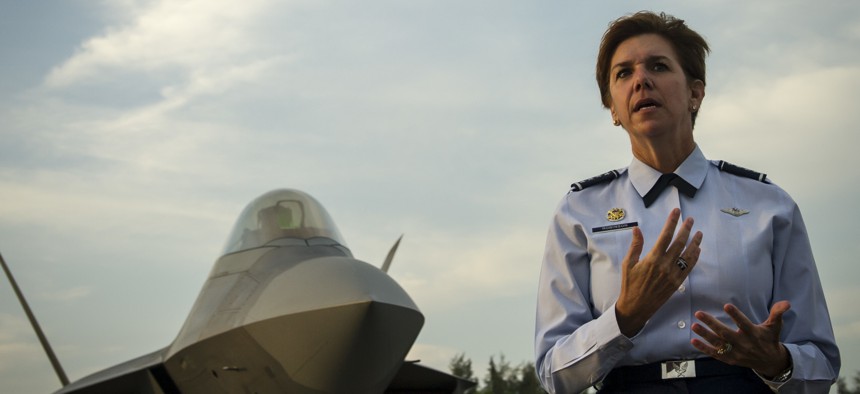
Gen. Lori Robinson, then-Pacific Air Forces commander, addresses U.S. and Singapore Airmen in front of an F-22A Raptor during the Singapore International Airshow, at Changi International Airport, Singapore, Feb. 17, 2016. U.S. Air Force photo by Capt. Raymond Geoffroy
As Threat of Russian Missiles Rise, NORAD Looks to the Future
No longer a Cold War leftover, NORAD and its new leaders will have their work cut out for them.
COLORADO SPRINGS, Colo. — Defense Secretary Ash Carter installed a new Air Force general atop the outfit that keeps the country safe from enemy air power: the North American Aerospace Defense Command, or NORAD.
NORAD, best known -- in pop culture, at least -- for tracking Santa and nearly ending life on Earth through poor software design and implementation in the 1983 Cold War movie WarGames, most recently made headlines in December when one of its missile-detecting aerostats (think: tethered blimp) became unmoored north of Washington, D.C., dragging its cable across a 160-mile stretch of the mid-Atlantic region, taking down power lines and causing other havoc.
So, you could be forgiven for thinking of NORAD as a relic of the Cold War. But Cold Wars don’t thaw quickly and the relevance of NORAD is on the rise. The change comes as Russia and China flex military muscles in their regions and increase spending on strategic missiles, and as North Korea pledges to develop its own missile capable of carrying a nuclear warhead to the continental United States. The U.S. has spent more than $108 billion on missile defense, so far, and is pressing ahead with a more modern and integrated missile defense. Last June, NORAD announced a new plan to bolster its ICBM defenses with new radars.
Commanding the effort is Air Force Gen. Lori J. Robinson, who will head up NORAD and U.S. Northern Command, or NORTHCOM. Robinson succeeds retiring Navy Adm. Bill Gortney and, in so doing, becomes the first woman to lead a combatant command, placing her in charge of one of the military’s nine chains of command, directly under the secretary of defense and commander in chief.
“As a strategic thinker and Joint Force leader, General Robinson has proven her ability to manage complex operations and work with partners across theaters and domains. These abilities will serve our nation well as NORAD and NORTHCOM continue their vital contributions to the counter-ISIL campaign and defense of the homeland,” Carter said.
Most recently, Robinson was commander of Pacific Air Forces, the top Air Force officer in Pacific Command. She previously was vice commander of Air Combat Command, and was deputy commander of U.S. Air Forces and of international air commands across the war zones of Central Command.
In 1982, Robinson entered the Air Force through the ROTC program at the University of New Hampshire. She’s run the command and control operations division at the Air Force Fighter Weapons School, was chief of tactics in the 965th Airborne Warning and Control Squadron, and deployed as vice commander of the 405th Air Expeditionary Wing to Afghanistan and Iraq.
Russia has been pouring money into new ICBMs and other missiles. Commander Sergey Karakayev, who leads Russia's Strategic Missile Force, boasted this month of new missiles built to defeat U.S. missile shields.
The new weapons “reduce [the] ICBM’s acceleration section, introducing new types of warheads with the flight path that is difficult to predict and new means of overcoming the missile defense system," Karakayev told Russian News Agency TASS.
He alluded to the U.S. decision to turn on an Aegis anti-missile base in Romania.
“This is conditioned by the fact that the United States is not stopping after what it has achieved and continues improving its missile defense system, including the deployment of its elements in Europe. That is why, special attention in the development of new missile complexes is paid to the issue of overcoming the missile shield," Karakayev said.
The Russians are also adding mobile missile launchers; they plan to have as many mobile launchers as stationary ones by 2021, according to TASS. They claim their new SS-30 missile can destroy an area the size of Texas.
“Moscow approved development of the SS-30 in 2009 as a replacement for the Cold War-vintage SS-18. Seven years later, the first rockets are reportedly ready for testing,” The Daily Beast reported.
Carter pointed out Friday that the U.S. anti-missile weapons aren't meant to stop Russian ICBMs.
“Our missile defenses are designed for Iran and North Korea," he said. "They are not designed for nor are they capable of defending the United States from the Russian nuclear force. The United States hasn’t had the capability…for many decades. Our protection against attack from any nation is deterrence."




